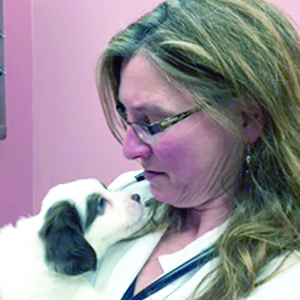
Episode 53
Tech Support, Part I: The Root of the Problem
Tackling the Technician Shortage Series See All Episodes »
What is behind the widespread shortage of technicians, and what can be done to reverse it? It’s a complicated question many organizations are asking but no one has yet been able to answer. In 2021, OVMA established a task force to investigate this worsening trend, and in the past year, it has dug deep into the root of the problem in an effort to better understand its complexities and identify potential solutions.
In this episode, Mia and Krysten kick off Fully Vetted’s new Tackling the Technician Shortage Series with members of the OVMA Technician Recruitment & Retention Task Force, who join us to offer three unique points of view on the same issue.
In part one, they delve into the history of the technician shortage and the factors that are driving it, discuss how it has affected the profession as a whole, and explain how the COVID pandemic has only exacerbated the problem.
Coming up in part two, we’ll explore the shortage from three different perspectives—the technician, the practice owner, and the educator—and discuss the myriad reasons technicians leave a hospital or the veterinary profession altogether.
Finally, in part three, we’ll look at the current state of technician education and training, possible improvements for the future, and ways veterinarians and practice owners can improve the technician experience to keep them happy, healthy, and employed.
Episode Guests

Diana Cron
DVM
Dr. Cron serves on the OVMA Board of Directors and is co-owner of Glenway Animal Hospital in Cincinnati.
Learn More »

Kelley Norris
RVT
Kelley is the assistant director of companion animal patient care at OSU Veterinary Medical Center.
Learn More »

Jennifer Wells
DVM
A former technician, Dr. Wells is the program director of the University of Cincinnati Blue Ash Veterinary Technology Program.
Learn More »
Transcript
Mia Cunningham: Alright. Welcome to the Fully Vetted Podcast, animal care news from the clinic to the farm, presented by the Ohio Veterinary Medical Association. My name is Mia Cunningham and I’m joined by my colleague Krysten Bennett. And today we have Dr. Diana Cron, RVT Kelley Norris, and Dr. Jennifer Wells on the show.Thank you so much for joining us, ladies.
Jennifer Wells: Thank you for having us.
Diana Cron: Thanks. It’s good to be here.
Kelley Norris: Thank you.
MC: So you all are members of the recently created OVMA Technician Recruitment and Retention Task Force. And before we get into the work of the task force and why it was created, I’d like for you each to tell us a little bit about yourself and your background. So we’ll start with Dr. Cron.
DC: I’m Diana Cron, appointed chair of this task force and also Vice President of OVMA this year. I’ve been a co-owner of a three-doctor companion animal practice on the west side of Cincinnati since 1995.
MC: Awesome. Kelley, would you like to go next?
KN: Sure. Hi, I’m Kelley Norris and I am a registered veterinary technician. I graduated in 1987 and I worked at Ohio State, first in ophthalmology and then right now as the chief nursing officer since 1990.
MC: And Dr. Wells?
JW: Hi, I’m Jennifer Wells. I actually graduated from veterinary technology school here in Cincinnati in 1992 and then went on to Ohio State for veterinary school. Since I graduated from veterinary school, I have been working at the University of Cincinnati Veterinary Technology Program, where I now serve as the program director for the last 14 years.
MC: Awesome. Well, thank you again, ladies, for being here.
Krysten Bennett: So as Mia said, the three of you are members of the OVMA Technician Recruitment and Retention Task Force, which was established in 2021 by then-President Dr. Ed Biggie. Dr. Cron, we’re going to direct this to you. Since you sit on the OVMA Board of Directors and you were there for that meeting, can you tell us a little bit about why the group was formed and what it is accomplished over the last year?
DC: Well, we were discussing how difficult it is to find registered veterinary technicians at an OVMA board meeting last year. The board decided it’s a very important issue to our profession and created a task force to further identify reasons for this and to explore potential ways to alleviate the problem. Our first virtual task force meeting was just about a year ago today.
MC: Now, understandably this is like a complex, multifaceted issue. So if you could start just by defining some of the challenges for our listeners and give us a little bit of context. Can you give us a history on the background of the shortage in this industry?
JW: Sure. I’ll go ahead and give some background information. As I said, I’ve been in the veterinary field since 1992. It has really been an issue that we’ve been discussing on the educational side, certainly for the last 20 to 30 years, there has been a chronic shortage of veterinary technicians graduating from schools. It’s a lot of things that go into the reasoning for it. We’ll be talking about some of those reasons later, but we certainly have had challenges that have not changed despite changes in the numbers of veterinary technician programs out there, changes in the way that we compensate our technicians in practices and other things as well. It’s been a challenge, and it doesn’t seem to be getting better in the current climate.
KB: Now, Dr. Cron, as you are a practice owner, can you break down what exactly a shortage of technicians means for the average veterinary clinic?
DC: Well, it means that we can’t do a lot of the things that we want to do. Over the years, we’ve had up to eight registered veterinary technicians, so that we could have a full surgery schedule and a full appointment schedule. And now we’re down to two full-time and two part-time and then some that just fill in sometimes. So that makes us short enough technicians that there are some days we can’t schedule surgeries and we have to scale back the number of appointments that we can see. It affects how many patients we can help, what we can do for them, and, of course, that affects our practice bottom line.
We’ve worked with UC Blue Ash veterinary technology program in a variety of ways. I myself was on the advisory board for years. We hosted practicums, preceptorships, and even lectured on various topics. Our lead technician and hospital administrators been with us for 26 of the 27 years we’ve been in practice. She’s a part time instructor there because a lot of times people are like, “Build a relationship with your local veterinary technology program, and that will help you grow technicians and find technicians.” And it used to work, but it doesn’t seem to be working for us like in the current environment. So we can’t do what we want to do because there just isn’t enough staff to help us.
KB: So it’s kind of like you’re treading water; you can’t expand at all.
DC: Exactly. We really utilize our technicians in our practice, and they do a lot of the dentistry, the dental cleanings, they place IV catheters, they prepare anesthesia, they intubate. They do a lot of the things that veterinary technicians are trained to do. So when we don’t have enough, it really puts a cramp in our style.
MC: Let’s dig a little deeper into that. So with the problem of scale, there’s really no way of identifying like a single root cause. But what do you see as a major factors driving the technician shortage?
KN: There seems to be a lot of different factors. One of the biggest is a lot of people are leaving the veterinary profession to go to human medicine. There is more money in human medicine, there is more respect associated with human medicine, and it’s sometimes not quite as physically demanding as veterinary medicine. In veterinary medicine, a lot of times people don’t understand that it’s very similar to a human nursing role. When they hear the technician word, they think that it’s somebody that’s just doing measuring or something—like an electrical technician, a job that is more blue collar, not necessarily a skilled nursing position.
And the other thing that comes into play is that there’s a knowledge of a bunch of different species rather than just one single species. So it is difficult. And people sometimes feel that it’s not worth what they are paid for that difficulty.
There also are a lot of places that don’t use their technicians to their full potential, that they will have them do sort of more menial tasks than the more skilled nursing things like the anesthesia and catheters and those sorts of things. They’ll have their technicians doing a lot of cleaning and stocking, which is certainly something that we can do. But there’s a lot of things that are more important that we can do than that.
JW: Yeah, I’d just like to piggyback on that. I think Kelley hit it on the head. I think that many technicians do leave the profession because they’re not valued and they’re not using their skills to their fullest. So certainly having enough veterinary technicians in your practice, using them to their fullest, supporting their professional development so that they can continue their education, all of that is really important.
But I’d also like to highlight that we’re also seeing challenges with people being interested in coming into the profession. And I think that—I don’t think, I know—that I have seen a decline in students over the last five years. We used to have a waiting list every single year. We would have more students than space. We actually expanded our student spaces about four years ago. Since that time, we’ve not been able to fill our classes, and it’s gotten really critical over the last couple of years.
So we’ve actually had people that have come to our open houses at the college. And these are students that are looking at prospective professions at the school. And they’ll come up and say, “I love working with animals. I would really love to be in this profession.” And after they talk to us, they may say, “I can’t afford to work for that amount of money, for what the starting salaries are, or even what the going wages for an actual technician that’s been out for several years.” And they’ll go past us and visit human healthcare professions, just like Kelley was mentioning.
So we have seen a decline both in our student numbers coming into the program, but also the students that are academically capable of getting through the program. Certainly there is something to be said about COVID and what everyone has gone through for the past two plus years. And I’m sure that many students coming out of high school may not have been academically as prepared as they may have used to have been. So we’re seeing a little bit of that as well. And we hope that will change as things get back to normal. But I think from the educator side, at least in my experience, when I talk to other technician educators in Ohio, many of us are seeing declines in student numbers, and so that doesn’t help at all because we’re trying to get them out into the practices, but they’re not coming to us in the first place.
KB: That’s so interesting, knowing that there are so many students who apply for veterinary school and don’t get in. You kind of have the opposite problem.
JW: Yeah, we definitely do. We used to be very similar. We’d have almost double the number of students compared to the space that we have in our classes. That was the typical for almost 20 years in our program here in Cincinnati. We’ve changed a lot of things to try to accommodate more students. We have a part-time evening program as well as our day program, and the numbers are definitely going down. We have less students in our freshman year courses, which is not our clinical hands-on nursing courses—so we have less students are even choosing it at the front end, unfortunately, and I don’t have an answer for all the answers to it.
I know salary is part of it because we’ve heard from those people or heard from the parents of those people who walk to the table next to us in the human health care field. But I know that we’ve had a lot of discussions on social media, and there’s a lot of information out there about how difficult the profession has been over the last several years. I hope that that isn’t contributing to it, but I feel like that may be turning some people away as well. When we talk about the risk of suicide and compassion fatigue and coupling that with the difficult working conditions, I know a lot of practices out there do a wonderful job of supporting their technicians, but I think there are other practices that could do a better job.
KB: Absolutely. Now the three of you are all based in Ohio, but is this problem affecting specific geographic regions, or is it something that’s industry wide, nationwide, widespread?
JW: Yeah, I can speak to that. I’m also on the American Veterinary Medical Association task force and working group on this technician utilization issue. We’ve been working at this problem for the last three years, and we’ve done some surveys, we’ve done some group work where we’re coming up with recommendations for the AVMA to help with this problem. And one of the things that we have found is there certainly is a difference in the United States. A lot of that has to do with regulations concerning technicians. Many of us are aware of the fact that across the United States there is a huge range of what is considered a licensed or credentialed veterinary technician. We are lucky in Ohio that we have pretty stringent rules and regulations that you have to graduate from an AVMA-accredited program and pass the national board exam to become a registered vet tech in Ohio, an RVT.
But in other states, you may have on-the-job training. You may be able to sit for the board exam without going to a technician school, and you may be able to call yourself a veterinary technician or become credentialed without either thing—so kind of on-the-job training with no board exam or no official schooling.
So when you don’t have that support of the profession across the United States, there certainly are areas where I always call it the wild wild west—and it’s not always in the west. I don’t want to make it sound like they’re bad guys out there—but it is difficult to advocate across the board for the profession the way the nursing profession can (because they’ve got very stringent guidelines about who can be a nurse and what their duties can be) when states have such differing opinions about what technicians can do and how you can become a technician.
I think in general, it’s worse in rural areas. I think that practices in rural areas have difficulty attracting students to move there in some cases. And that tends to be kind of across the United States, a trend that we see, compared to urban areas, where they may have higher pay scales or corporate practices or academia where they may be able to pay their employees a little higher or offer more benefits. But it definitely is a huge issue.
DC: Actually, if I might interject: This morning on my email, I got a survey from AAHA that asked a lot of the same questions we are asking. Are you short veterinary technicians? Are you short veterinary assistants? The survey kind of had that feel that they were trying to get answers to this problem as well. So I think all aspects of veterinary medicine are feeling the crunch, and they’re trying to do something about it, or they’re at least exploring it.
MC: So in your opinions, how has COVID impacted the shortage?
KN: One of the things that happened with COVID was that people were having a hard time getting into their general veterinarians and so they were postponing things until animals were really sick. And it has pretty much blown up the emergency case load, which has then made it harder for some of the specialty and referral hospitals to get patients in. It seems that there’s a lot more patients trying to come in on an emergency basis or to see the specialists, and it’s harder for them to get appointments. And with a lot of practices doing curbside, we had to reduce schedules and the amount of people that were in the buildings and those sorts of things. So the demand has gone up, and then we had to cut cases back. So it’s made it a lot more difficult.
DC: From the private practice perspective, we had to cut our hours back because we just didn’t have the staffing. We tried to do teams so that people were separated, and you were on one team or the other, so that you didn’t have everybody commingling. But that was difficult. So we had to cut our hours back quite a bit.
The curbside service had to be instituted very rapidly. We had to do it, like right now, once we found out we were allowed to start practicing again and actually seeing patients again. And it just added so many extra layers of stress for the people that had to go out in the ice and the snow and get animals out of their cars and bring them into the building. And our office is located on a really busy street. So we couldn’t really go outside to talk with the client because cars would be whizzing by and you couldn’t hear anything. So it was one extra step. It was several extra phone calls that you had to make. You had to call them to find out their history. And then there was so much we had one day when our phones went down, that was a real mess because people were expecting to call, and then they couldn’t get in touch with us. So that was crazy.
But then some of the clients were just really cranky about the whole safety protocol thing, and we lost some clients and had to fire some clients. People would be frustrated because they couldn’t get in, and people would call and want to become new patients because they went out and got a new puppy or a new pet, and we just couldn’t handle the caseload. And then initially, early on, we weren’t allowed to do any surgery except for life-saving procedures, and we weren’t staffed for it either. So it was really a difficult situation.
KB: So you mentioned splitting up your staff, which would make your shortage even more pronounced, because if you have two technicians split into two groups, you have only one technician on each group, which means that one technician is doing everybody’s job for that particular group.
DC: Right. And then there were people that would get sick or their kids would get sick, or their kids were home from school, and they had no child care, no place to send them. So we had a lot of people that were out for various reasons during that timeframe as well. And so it just really made the situation difficult.
KB: Right. It’s like kind of like a domino effect. You hit one wrong thing, that could take out your entire practice, and then you just exacerbate everything.
DC: Right. People in the veterinary profession have always prided themselves on “Well, I’ve got sore throat but I’m going to go to work anyway. I can power through it because my team is depending on me.” But you couldn’t do that during COVID; if you didn’t feel good, you had to fess up and say, “I don’t feel good, and I’m showing signs that could be COVID,” and you had to stay home whether you wanted to or not. You just had to. So it made everything that much worse.
KN: I think it affected everybody, because even those of us with larger staff, we still for a while were only doing emergency procedures and emergency appointments. We tried the cohort thing, which again didn’t work very well, even with the bigger staff, because you still have to make sure that people aren’t commingling in between services.
And the other thing that was a little bit hard for us was that we have so many different services that we had to actually created a triage team, which we didn’t have the people for. So we had to pull people out of specialty services and put them on the triage team so that they could make sure that the emergencies that needed to get right in were getting directly back to the emergency room, whereas the ones that could wait for a minute were able to wait. So it was a little bit challenging in that sense too. And then we had to also try to avoid the domino effect of something being really sick and not getting to see anybody right away, and have it be really bad for that particular animal. You hear the stories about people in emergency rooms dying in the emergency room, because they haven’t gotten back to see the doctor. We definitely didn’t want to have that happen here. Fortunately we didn’t, but there were a couple of days where we were trying to get patients to make sure that everybody got seen in an appropriate amount of time.



